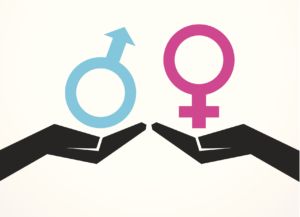
A person sits in the park, sitting with their legs crossed and their arms extending, gazing into the camera with a half-smile.
What draws you to yoga?
If you’re reading this article, I’m guessing there’s something about it that appeals to you. Is it how it makes your body feel? The chance to do something good for yourself? The way it helps you get centered?
Every year, more and more people are learning about the benefits of a yoga practice, and that can be wonderful.
And, as yoga gets more popular in mainstream culture, more and more people who aren’t connected to the practice’s roots are picking it up.
In the US, for example, the image of yoga is often associated with white, thin, able-bodied, middle class women. If you’re one of these women, yoga is being marketed to you all over the place, and might not have noticed anything wrong with the way it’s being advertised.
If you’re white, there’s not necessarily anything wrong with you doing yoga. You’re probably just doing it for your own wellness, so it might be strange to think you could be hurting anyone else.
The problem lies not with you doing the practice, but with how yoga is commonly practiced and commercialized in Western contexts like the US.
Cultural appropriation is a process that takes a traditional practice from a marginalized group and turns it into something that benefits the dominant group – ultimately erasing its origins and meaning.
And that’s exactly what’s happening with yoga in Western spaces. The practices are based on traditions that go back thousands of years in South Asia and other places around the world, including East Africa’s Kemetic Yoga. But this context and much of the essence of yoga’s meaning has been stripped away.
This has a damaging impact – though I know you don’t mean to cause any harm. So let’s unpack the impact of culturally appropriative yoga, so that you can figure out how to make sure you’re not contributing to harm.
I’ve spoken with nisha ahuja, an accomplished justice educator and facilitator who is known for her work addressing cultural appropriation of traditional healing practices.
This information offers nisha’s wisdom and the knowledge of those who have informed her work, and it’s an invitation for you to deepen your understanding of yoga practices and how they relate to building a more equitable world.
nisha speaks from a South Asian context, with yoga practiced as medicine and a spiritual path in places like India for thousands of years. All over the world, similar healing practices have existed in places that were colonized.
You can find more acknowledgments at the end of the piece, but nisha would particularly like to give thanks to collaborator and contributor Melissa Moore, a Black and Cherokee justice, healing, and Dharma practitioner; friends, community, and colleagues who are Black, Indigenous, Non-Caste Privileged South Asians, cash-poor, disabled, and abundant bodied; and members of Bending Towards Justice and Brown Girls Yoga.
nisha wants to be clear that this isn’t about reclaiming yoga for Hindus as some right wing extremism calls for – that’s counteractive to the work. It’s about understanding the complexities of oppression within the Western context of your yoga practice.
Even within a South Asian context, yoga incorporated practices from Indigenous peoples and those who would later be excluded through the caste system, which most often goes uncredited – so yoga that’s exclusionary has always had a negative impact on the oppressed.
And this is only the beginning of how cultural appropriation can cause harm. If you’re able to notice when this is happening, then you can continue to build your yoga practice in a way that benefits you and helps you avoiding harming other people.
Here are some signs of cultural appropriation to watch out for – and some ideas for how to build a more healing practice.
1. You’re Treating Yoga Like a Solely Physical Activity
Many people think of yoga as a type of exercise, and nothing more.
If physical health is all you get out of your yoga practice, you deserve to be able to take care of your body. But it is important to know that the physical aspect of yoga isn’t all there is to it – and in most lineages of yoga, the physical component is just a small fraction of the practice.
Yoga is also a spiritual path – and the story of how it got turned into the form of exercise you know today isn’t a pretty one.
Through colonial suppression of Yogic practice and spirituality during the British Raj, one could be violently persecuted for not converting to Christianity or for publicly promoting Yogic teachings.
This catalyzed a coercion towards Western style athletics and aesthetics, so “turn of the century” (1800s to 1900s) body building and showmanship culture in some lineages of yoga were reemerging publicly. Many lineages maintained the deep spiritual practices, but had to keep these teachings private for fear of violent repercussions.
Throughout the history of colonization, demonizing the spiritual practices of Indigenous people and people of color is part of how colonizers have justified violence against them.
Those practices have played an essential role in many people’s healing, health, and survival. So it’s important that we don’t redefine yoga as a solely physical practice.
Doing so relies on racist thinking – legitimatizing what white and Western people like about yoga, and invalidating its original meaning.
Many of the yogic teachings that were brought to the West were done so with this continual colonial coercion, with a need to appease and appeal to the Western mind by making connections of yoga to Christianity and/or defining it as a physical activity.
So if you want to do physical exercises based on yoga practices, it’s possible to do that without contributing to oppressive ideas. Just acknowledge that you’re only doing the physical practices.
By specifying that this is an exercise derived from yoga practices – not the entire practice of yoga itself – you can avoid mischaracterizing what yoga is all about.
2. The Practice Includes Shame and Ridicule
Going hard and pushing yourself in order to get a good workout works for some people, but it’s not for everyone.
And when “pushing yourself” means being shamed for your body or abilities, it can take a toll on your sense of self-worth.
Shame is not part of the practice of yoga. But some studios operate as if getting “hot,” straining to the brink of exhaustion, and feeling humiliated is what yoga is all about.
So what does this mean for your practice? Well, if it’s stressing you out, then it’s not what yoga is meant to be.
As is central in yogic practices, there should be compassion, not ridicule, and a sense of internal ease, instead of poses that cause your body stress.
You can honor the pace that’s best for your body, instead of overexerting yourself.
3. You’re Not Acknowledging Where the Practices Come From
Neglecting to recognize the origins of what you’re using is a classic sign of cultural appropriation.
You may not mean to participate in the system of white supremacy by doing this, but it’s part of how the system operates – by removing any trace of people of color from the positive things we create.
So if you get on board with “yoga” that’s marketed as a hot, New Age trend, you’re supporting a business model based on theft and disrespect for a thousands-year-old history.
Maybe you’re wondering: What does this long history have to do with you practicing yoga today?
Well, humbleness and humility are foundations of a yoga practice. Through interconnectedness, you recognize that you didn’t come up with these practices all on your own. You show respect to the teachers who have come before you, and the people they learned from.
You can approach your own practice with humility, and look out for it in your yoga teachers, too.
If the person leading your session is put up on a pedestal without any acknowledgment of the people or regions that yoga practices come from, they’re contributing to destroying the lineages that many folks are fighting to protect.
You can try talking to them about acknowledging the origins of yoga in the practice – or consider supporting another space that’s more grounded in yoga’s roots.
4. You’re Misusing Sacred Objects
Hopefully, if you and your yoga teachers knew the significance of sacred objects, you wouldn’t intentionally use them in disrespectful ways.
But lots of people include sacred objects in their yoga practice without realizing the significance of what they’re using.
Sometimes, it’s an attempt to give an “authentic” flare to a yoga studio – but misusing a sacred object as nothing more than a piece of décor is a dead giveaway that you don’t have a real grasp of authenticity.
Anyone who uses a cultural item they’re not familiar with should do their research to understand where it comes from, what it means, the protocols of engaging with and utilizing it, and how it should be cared for.
For instance, anything used in healing or spiritual practices – like scriptures, crystals, and statues of Buddha – is meant to be treated with respect.
If you use these objects for your own purposes, you’re not respecting them or the cultures they come from. You’re just exotifying and fetishizing other cultures without really understanding them.
For comparison, you probably wouldn’t use pages of a Bible as decoration without understanding anything about Christianity.
So if you spot a sacred item on the ground or being used for toilet decoration in a yoga studio, you might want to have a word with the staff.
They don’t have to know everything about the items they’re using – but they should make an effort to have someone around who has that knowledge or is learning.
5. You’re Not Being Accountable When Speaking Sacred Languages
Many Western yoga spaces treat sacred languages the same way they treat sacred items – without knowledge or respect for what they’re using.
For instance, you might use Sanskrit, or chant without knowing what you’re saying or why.
Sound can be healing, and you don’t necessarily need to learn a whole new language to get something out of chanting. But, just like with the sacred objects, you could have a harmful impact if you use language without understanding its significance.
It can be hurtful for South Asian people to hear their traditional languages being misused, butchered, and even laughed at.
In a South Asian context, Sanskrit is caste exclusionary. There may be people in the room who have been affected by that system of inequality, and your use of the language could be the opposite of healing for them.
When nisha is leading a yoga session and she uses Sanskrit, she lets people know that they’re going to use it and what they’re going to be saying. She contextualizes the caste and religious divides that Sanskrit has and can create, and shifts the intention of using Sanskrit to engage the energy channels of our physical and subtle bodies.
Pay attention to how your yoga practice treats sacred texts, languages, and chants.
6. A White Person Who Ignores Oppression Is Leading the Practice
Avoiding cultural appropriation isn’t about getting white people to stop participating in yoga or leading yoga sessions. But when the only option for studying yoga is to learn from a white person who ignores the complexities of oppression, that’s a problem.
And that’s happening in yoga spaces where white teachers don’t acknowledge or address how white supremacy can show up and marginalize people of color.
For instance, there are lots of opportunities for people who fit the mainstream image of the industry – thin, white, middle class women – to get funding, space, and respect as leaders deemed experts.
As a result, for a South Asian or Black person trying to access yoga teachings from South Asia or Africa, it takes a lot of work to find an authentic connection with a teacher who is carrying on the traditions – not just leading a diluted form of them.
On the other hand, people who are working to create more inclusive spaces, like nisha, face barriers in getting support from a white-centered industry.
That doesn’t mean it’s wrong for you to support a white yoga facilitator. But you can recognize how the industry marginalizes those who don’t fit the mainstream image of “modern” Western yoga.
All kinds of folks are being excluded. Not only teachers, but also practitioners who are poor, people of color, disabled, transgender and non-binary, fat, and more.
To be more inclusive of people who don’t fit the dominant norm, white leaders need to recognize why marginalized people don’t feel welcome and commit to do something about it.
If your teacher is a white person who fetishizes the practices without acknowledging where they’re from, there’s a good chance that they’re not committed to recognizing their privilege and minimizing their harm in the world.
Some teachers present themselves as experts on South Asianness or yoga – and it’s a problematic trend of white supremacy to center them as the experts, rather than trusting and elevating the knowledge of people who are actually part of these cultures.
As a consumer of this industry, you can show your support for respectful engagement with yoga practices by seeking out facilitators who are respectful in their practice.
7. You’re Treating Yoga Like a Commodity
A compassionate healing practice like yoga has to go through a lot of changes to fit a system of capitalism and white supremacy.
So you know you’re getting a culturally appropriated version of yoga when it’s all about the money.
Think of yoga accessories and fashion lines that big corporations profit from, or studios aiming to make as much money as possible.
Yoga practices are about sustaining ourselves in ways that have nothing to do with money or material possessions. When it turns into something that’s sellable, it loses its sacred value.
Unfortunately, treating the cultures of people of color this way, especially Black and Indigenous peoples, is a common trend in the US. Cultural appropriation strips the essence of our cultures away, reducing it to something the dominant culture can use for profit and entertainment.
Meanwhile, anything that can’t be turned into a profit isn’t considered valuable.
Yoga practices can help us reconnect with the parts of ourselves that oppression tries to get rid of. So be wary of spaces that treat yoga as a trendy possession to be bought and sold.
Those cute matching accessories might be calling your name. But if they’re calling you to give your money to a corporation that’s not supporting a traditional yoga practice, that purchase could have a negative impact.
You can help preserve traditional yoga practices by engaging with them outside of that commercialized mold.
8. You’re Only Thinking About Your Own Personal Gain
How do you benefit from yoga?
Maybe the practice has had a positive influence on your mental health, your body, or your personal life. Taking care of yourself is such an important act of self-love, and we don’t get encouragement to show love to ourselves nearly often enough.
So when people ask you to avoid appropriation, you might think they’re saying you have to give up thinking about your own self-care altogether.
That’s not what we’re saying. It’s awesome that you can show yourself love through yoga practices.
And you have the opportunity to shift the oppressive pattern that so many of us are taught to follow – the one that encourages you to take what benefits you on the surface without considering the impact on other people.
A system that only values you for your bank account doesn’t actually value who you really are.
But an authentic yoga practice can help you grow as your whole self – mind, body, and spirit. Embracing your wholeness includes recognizing that you are part of a big, beautiful collective of other beings.
Thinking of others gives you a chance to think twice before feeling entitled to take from them for your own personal gain. If you’re using something in your self-care practice that didn’t originate in your culture, do some research so you don’t adopt this practice in a way that harms people.
Try opening up to the compassionate side of a yoga practice. Include your love for yourself and consideration for others by avoiding appropriation, learning about the roots of yoga, and supporting inclusive spaces.
Why the Appropriation of Yoga Matters
If these signs of cultural appropriation are familiar to your yoga practice, that doesn’t mean you’re a bad person.
We’re all taught to follow the systems of oppression that dominate our society, and every one of us has to go through a learning process to decolonize our thoughts and behaviors.
If you’re doing yoga for reasons as personal as getting in touch with your own body, I understand why you may be confused about about this issue. Are you really hurting anyone?
Here’s some background info on why the appropriation of yoga is important to think about.
The word “yoga” comes from a word meaning “union” – which explains that connection you feel between mind, spirit, and body.
And yoga practices also include the connection between yourself and others, for collective healing and liberation. That means being thoughtful about your impact on others as you move through the world.
Cultural appropriation is a perfect example of how you can cause harm if you’re not thoughtful about your impact in the world.
If you think only of yourself and how you benefit from practicing yoga, it’s possible that you’ll inadvertently further marginalize the people of the cultures that it comes from. But if you consider that your behavior can affect other people, you’ll take into account the history and context of what happens when yoga is appropriated.
For an example, let’s talk about what that looked like in South Asia – though that’s not the only origin of yoga, and it’s important to remember, for instance, its African roots as well.
The British used violence, rape, and murder to take control of the South Asian sub-continent – and they approached yoga with violence, too. They forced people to convert to Christianity, and outlawed the healing and spiritual practices seen as “primitive” traditions, like yoga.
So how did South Asian and African people preserve yoga through all of that? With incredible resilience – and also by taking huge risks, with many of them losing their land and their lives.
With yoga being so popular these days, it’s hard to imagine having to go through all of that just to practice it.
But unfortunately, this history has left a legacy of racism and domination that continues in Western approaches to yoga today.
Erasing and exotifying the South Asian and African roots is part of the story of how yoga was originally brought to Westerners.
After being demonized as a “savage” characteristic of the cultures of people of color, yoga was then repackaged in some schools as something white people could enjoy for entertainment and competition’s sake.
These racist double standards still exist, as South Asian in Western places people are mistreated when they follow their cultural traditions, while white people gain profits, attention, and credit for using diluted versions of the same practices.
This is why it’s dangerous to accept yoga as it’s presented in mainstream images and marketing. There’s so much more to it than the diluted version that’s being sold to us.
Not only are you missing out on part of the practice – by buying into the mainstream industry’s version of yoga, you’re also only viewing yoga through a Western lens. This lens distorts what yoga is supposed to be, and adds racism, exotification, and exclusivity.
The more the practice of yoga is dominated by this commercialized distortion, the more society invalidates the authentic healing practices of people of color.
So those deep yoga practices that helped many South Asian and African people and other folks of color survive colonization and continue to help them survive marginalization today? Those are getting harder and harder to access, which means vital information about healing medicine is being lost.
If someone points out that you could do your yoga practice differently to help avoid this harm, consider it a gift. As nisha puts it, “It’s a gift to learn how to love bigger.”
With authentic yoga practices, you can love bigger, grow your compassion for yourself and others, and have a positive impact that radiates brilliantly through the world.
For more on this topic, watch You Are Here, a video featuring nisha ahuja discussing the impact of the cultural appropriation of yoga.
In the spirit of acknowledging the wisdom of others, nisha would like to thank:
- Members of Brown Girls Yoga
- Members of Bending Towards Justice
- Melissa Moore
- Sairupa Krinshnamurti
- Sheila Batracharya
- Ann Marie Hood
- Tannis Neilson
- Heather Greeves
- Bibi Rahim
- Prachi Patankar
- Third Root Community Health
- Six Degrees Community Health
- Yashna Maya Padamsee
- Socorro Dalton
- Decolonizing Yoga
- South Asian American Perspectives on Yoga (SAAPYA)
- Healing Justice Network that has grown out of the Allied Media Conference
- The multitude of friends, community and colleagues who are Black, Indigenous, Non-Higher Caste South Asians, cash-poor, differently-abled, and abundant bodied sharing knowledge and brilliance
[do_widget id=’text-101′]
Maisha Z. Johnson is the Digital Content Associate and Staff Writer of Everyday Feminism. You can find her writing at the intersections and shamelessly indulging in her obsession with pop culture around the web. Maisha’s past work includes Community United Against Violence (CUAV), the nation’s oldest LGBTQ anti-violence organization, and Fired Up!, a program of California Coalition for Women Prisoners. Through her own project, Inkblot Arts, Maisha taps into the creative arts and digital media to amplify the voices of those often silenced. Like her on Facebook or follow her on Twitter @mzjwords.
nisha ahuja contributed to this article, which we are ever grateful for. nisha is co-founder and co-director of Soma Ayurveda + Integrative Wellness, a social enterprise for wellness, education + equity, which shares a growing number of online and in-person resources. She shares Ayurvedic Medicine and Body Work, Holistic Yoga, Reiki and Attmic Energy Healing and is also an actor, physical theatre creator, playwright, singer/songwriter, and art, wellness, and justice educator/facilitator, having shared these offerings across Canada, the USA the Netherlands, and India. She is dedicated to dissolving the boundaries between art, traditional/ancient medicines, spirituality, and politic, and believes that art and healing practices are revolutionary and fundamental to our collective liberation.
nisha is known widely for her video “You Are Here: xxploring yoga and the impacts of cultural appropriation” and in Toronto, for sharing her Self-Healing Through Yoga Series several times a year, co-manifesting the Ayu-Yog Meditation Retreat For Women and Trans Indigenous Peoples and Peoples of Colour (with Sairupa Krishnamurti), as a facilitator/member of Brown Girls Yoga Collective, and her summer series Yoga in Dufferin Grove Park, as well as across North America for her workshops on wellness, spirituality, theatrical practices, justice, racial justice, and addressing cultural appropriation. Alongside collaborator/contributor M. Jet Feather, a Black and Cherokee justice, healing, and Dharma practitioner who has contributed to nisha’s spiritual journey immensely, and other Yoga and justice facilitators with Bending Towards Justice, nisha continues to bring these offerings to spaces across North America. More info: www.somaintegrativewellness.com
Search our 3000+ articles!
Read our articles about:
Our online racial justice training
Used by hundreds of universities, non-profits, and businesses.
Click to learn more
Most Read Articles
- « Previous
- 1
- …
- 30
- 31
- 32



















